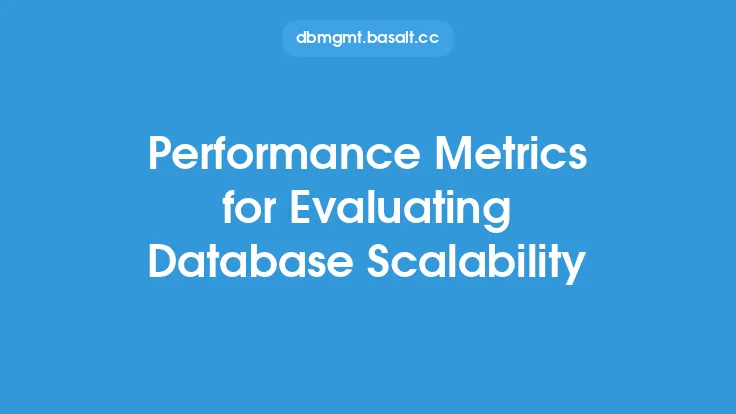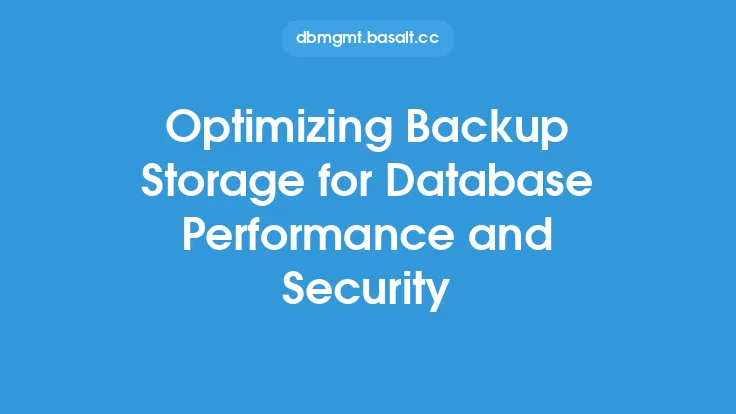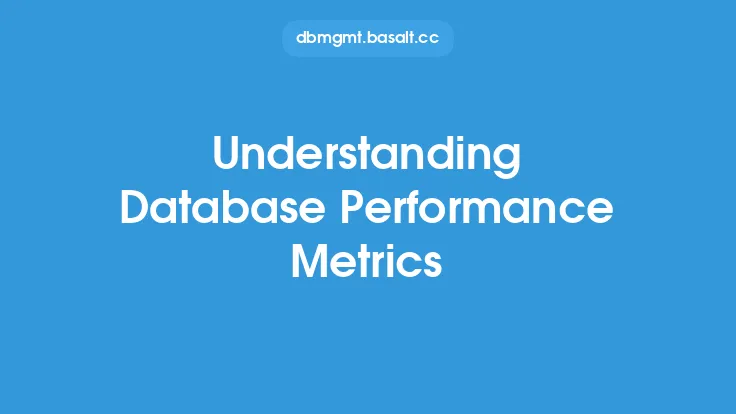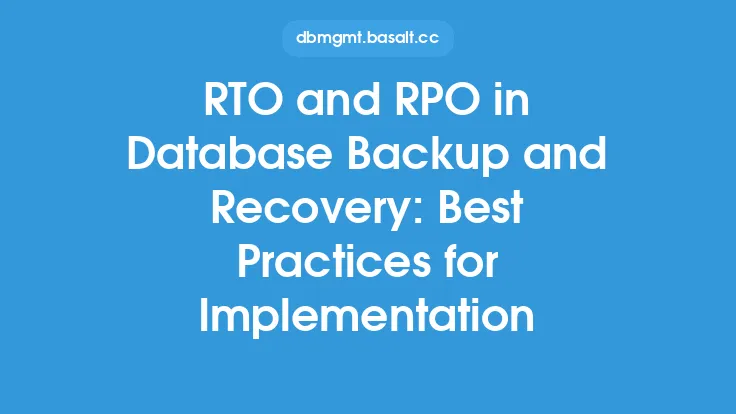Evaluating the performance of database backups is crucial to ensure that data is properly protected and can be recovered in case of a disaster or data loss. Database administrators need to monitor and analyze various metrics to determine the effectiveness of their backup strategies. In this article, we will delve into the key metrics and monitoring techniques used to evaluate database backup performance.
Introduction to Database Backup Performance Metrics
Database backup performance metrics provide insights into the efficiency and reliability of the backup process. These metrics can be broadly categorized into three groups: backup window metrics, storage metrics, and recovery metrics. Backup window metrics measure the time it takes to complete a backup, including the duration of the backup process and the time spent on tasks such as data transfer and validation. Storage metrics, on the other hand, track the amount of storage space used by backups, including the size of the backup files and the retention period. Recovery metrics measure the time it takes to recover data from backups, including the time spent on tasks such as data restoration and verification.
Key Performance Indicators (KPIs) for Database Backup Performance
Several key performance indicators (KPIs) are used to evaluate database backup performance. These KPIs include:
- Backup success rate: This measures the percentage of successful backups completed within a given time period.
- Backup completion time: This measures the time it takes to complete a backup, including the duration of the backup process and the time spent on tasks such as data transfer and validation.
- Data transfer rate: This measures the rate at which data is transferred during the backup process, typically measured in megabytes per second (MB/s) or gigabytes per second (GB/s).
- Storage utilization: This measures the amount of storage space used by backups, including the size of the backup files and the retention period.
- Recovery time objective (RTO): This measures the time it takes to recover data from backups, including the time spent on tasks such as data restoration and verification.
- Recovery point objective (RPO): This measures the point in time to which data can be recovered, typically measured in minutes, hours, or days.
Monitoring Techniques for Database Backup Performance
Several monitoring techniques can be used to evaluate database backup performance. These techniques include:
- Log analysis: This involves analyzing log files generated by the backup software to identify trends, patterns, and errors.
- Performance monitoring tools: These tools provide real-time monitoring of backup performance, including metrics such as CPU usage, memory usage, and disk usage.
- Backup reporting: This involves generating reports on backup performance, including metrics such as backup success rate, backup completion time, and storage utilization.
- Alerting and notification: This involves setting up alerts and notifications to notify database administrators of backup failures, errors, or other issues.
Tools and Technologies for Evaluating Database Backup Performance
Several tools and technologies can be used to evaluate database backup performance. These tools and technologies include:
- Backup software: This includes software such as Oracle RMAN, Microsoft SQL Server Backup, and IBM DB2 Backup, which provide features such as backup scheduling, data compression, and encryption.
- Monitoring tools: These tools include software such as Nagios, SolarWinds, and Microsoft System Center Operations Manager, which provide real-time monitoring of backup performance.
- Cloud-based backup services: These services include cloud-based backup solutions such as Amazon S3, Microsoft Azure Backup, and Google Cloud Backup, which provide features such as automated backup scheduling, data compression, and encryption.
- Database management systems (DBMS): These systems include software such as Oracle, Microsoft SQL Server, and IBM DB2, which provide features such as backup and recovery, data compression, and encryption.
Best Practices for Evaluating Database Backup Performance
Several best practices can be followed to evaluate database backup performance. These best practices include:
- Regularly monitoring backup performance: This involves regularly monitoring backup performance metrics such as backup success rate, backup completion time, and storage utilization.
- Analyzing log files: This involves analyzing log files generated by the backup software to identify trends, patterns, and errors.
- Testing backup recoveries: This involves testing backup recoveries to ensure that data can be recovered correctly and efficiently.
- Optimizing backup schedules: This involves optimizing backup schedules to ensure that backups are completed within the allocated backup window.
- Ensuring backup data integrity: This involves ensuring that backup data is handled correctly and efficiently, including tasks such as data compression, encryption, and validation.
Common Challenges and Limitations
Evaluating database backup performance can be challenging due to several factors. These factors include:
- Complexity of backup environments: Backup environments can be complex, involving multiple databases, storage systems, and network infrastructure.
- Limited resources: Database administrators may have limited resources, including time, budget, and personnel, to devote to evaluating backup performance.
- Lack of standardization: Backup processes and procedures may not be standardized, making it difficult to compare and evaluate backup performance across different databases and environments.
- Limited visibility: Database administrators may have limited visibility into backup performance, making it difficult to identify trends, patterns, and errors.
Conclusion
Evaluating database backup performance is crucial to ensure that data is properly protected and can be recovered in case of a disaster or data loss. By monitoring and analyzing key performance indicators such as backup success rate, backup completion time, and storage utilization, database administrators can identify trends, patterns, and errors, and optimize backup schedules and processes to ensure efficient and reliable backups. By following best practices such as regularly monitoring backup performance, analyzing log files, and testing backup recoveries, database administrators can ensure that backup data is handled correctly and efficiently, and that data can be recovered correctly and efficiently in case of a disaster or data loss.





